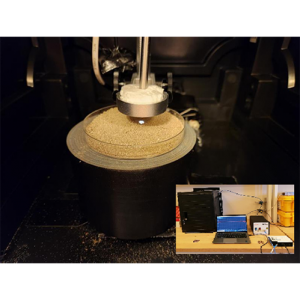ARA Spectron’s Spectroscopy Application Challenge for the year 2023 has officially closed. Researchers from UAE and KSA participated in the challenge. We received very interesting applications from different research centers and universities. Thank you and CONGRATULATIONS to ALL the participants.
Due to the lots of amazing submissions and since it was very hard to choose one winner, we decided to consider 3 winners. The 1st Place winner will receive 10,000.00 AED Cash as we promised before. The 2nd Place and 3rd Place winners will receive a gift coupon with value of 3000.00 AED and 2000.00 AED, respectively for their next purchase from ARA Spectron.
Check out our winners below:
1st Place Spectroscopy Application winner-10,000.00 AED cash
Khalifa University, Abu Dhabi, UAE
Submitted by Abdel Rahman Satei Hussein Alsaleh
Summary: Prediction of Soil Organic Carbon in Arid Regions Using Hyperspectral Spectroscopy: UAE Case Study
Soil organic carbon (SOC) plays a pivotal role in numerous ecological processes and holds significant implications for soil health, carbon cycling, and mitigation of climate. Therefore, the accurate measurement of SOC is essential for understanding its spatial distribution, monitoring changes over time, and making informed management decisions. Traditional methods of SOC measurement, such as titration, colorimetric, and loss of ignition methods, are labor-intensive, time-consuming, and often limited in spatial coverage. Therefore, this study adopted the spectral analysis method that has become more popular with undeniable advantages over traditional methods to estimate SOC. The objective of this study is to use these spectral reflectance measurements to develop models that can predict SOC. A total of 59 soil samples were collected from the agricultural fields in the United Arab Emirates (UAE) and analyzed in a laboratory for testing the SOC using the Walkley and Black wet combustion method. Spectroscopic measurements for these soil samples were collected under stable laboratory conditions using two instruments to cover the full range of wavelength: Ocean Insight HR2000+ (400 to 950 nm) and ARCoptix (900 to 2600 nm). A dark box configuration was used according to the CSIRO protocol for laboratory soil spectral measurements to take the reflectance measurement under stable conditions and to minimize any external light contamination. Moreover, a halogen lamp was used as a light source, where the reflected light was transmitted from the target using a fiberoptics cable to the spectrometer. A white reflectance standard with nominal reflectance of 99% was placed on the target stand and measured in the same setup using the two instruments after warming up for 20 minutes to obtain reflectance measurements, followed by replacing the white reflectance with a sample holder containing 5 cm depth of soil sample; the instruments were re-calibrated every 15 minutes. Therefore, the raw spectra of 2902 bands were pre-processed to ensure an optimal correlation and noise removal and the Partial Least Squares Regression (PLSR) method was applied afterwards with leave-one-out cross-validation approach. The resultant best fit PLSR model has shown a coefficient of determination (R2) of 0.99 for training, and 0.94 for prediction of SOC, for the SOC range of 0.46-3.15% (mean: 1.5%). The spectral signal of SOC was found to be significant across different wavelengths of the visible (401.97 -417.23, 450.89-452.27, 448.59 and 461.93 nm) and near infrared (931.68-1054.41 and 2527.81-2601.46 nm) regions. This research is the first step toward developing a spectral library of materials in the UAE.

2nd Place Spectroscopy Application winner- 3,000.00 AED coupon for next purchase
King Abdulaziz University, Jeddah, KSA
Submitted by Reem M Altuwirqi
Summary: Classification of Edible Salts Using Raman Spectroscopy Coupled with Principal Component Analysis
Raman Spectroscopy is an effective optical technique for molecular vibration modes analysis. It has numerous advantages such as being easy and rapid with no loss of accuracy and can be applied to diverse samples. A Raman spectrum can be regarded as a fingerprint to the structure of molecules which assists in characterizing materials. In this work, Raman Spectroscopy coupled with an exploratory tool such as principal components analysis (PCA) is applied for identifying and categorizing 24 edible salts available in the local market of Jeddah, Saudi Arabia. The results show the effectiveness of Raman spectroscopy and PCA analysis in discriminating the kinds of edible salts based on their origin (rock or sea). This was accomplished through the analysis of a narrow region between 2800-3800 cm-1 (OH band)., which was a sufficient region to obtain an excellent discrimination between the salt samples based on their origin. However, the technique was not successful in detecting the difference between natural and refined salts. This suggests the difficulty in distinguishing the chemical treated refined salts. This study could be used to classify edible salts based on their origin.

3rd Place Spectroscopy Application winner- 2,000.00 AED coupon for next purchase
University of Sharjah, Sharjah, UAE
Submitted by Ahmed Amine Hachicha
Summary: The use of Ocean Optics miniature Maya2000 Pro Fiber Optic Spectrometer to determine the reflectance of CSP mirrors
This research was conducted at the university of Sharjah in the objective to measure the soiling loss in the reflectivity of CSP mirrors and determine its impact under UAE and similar weather conditions. In order to accurately measure the solar weighted specular reflectivity, both specular reflectivity and hemispherical solar weighted reflectivity should be determined. Several mirrors were placed in a wooden stand at different tilt angles and directions at the university of Sharjah. The specular reflectance was measured using the Multiple Wavelength Portable Specular Reflectometer Model 15R-RGB manufactured by D&S. The hemispherical reflectance is obtained using Ocean Optics miniature Maya2000 Pro Fiber Optic Spectrometer coupled with ISP-REF Integrating Sphere. The schematic of the experimental setup is shown in figure 1. Based on the reflectance measurement campaign, monthly and cumulative soiling losses were obtained for an exposure time of more than three months. A drop of 63% in specular reflectivity was recorded from the reflectance measurement. This drop of reflectance could lead to a decrease of 36% in thermal efficiency of solar concentrator. Moreover, the soling effect is compared between CSP and PV technologies under the same conditions. It was revealed that CSP systems are more affected by soiling with 3-5 times more losses compared to PV systems. This work could help the in better understanding the dust effect on CSP performance under desertic climate and therefore assists in selecting the adequate cleaning strategies and frequencies.

Thank you to everyone who applied to the Spectroscopy Application Challenge this year!
Please reach us on Website and LinkedIn to receive all our informational updates!


